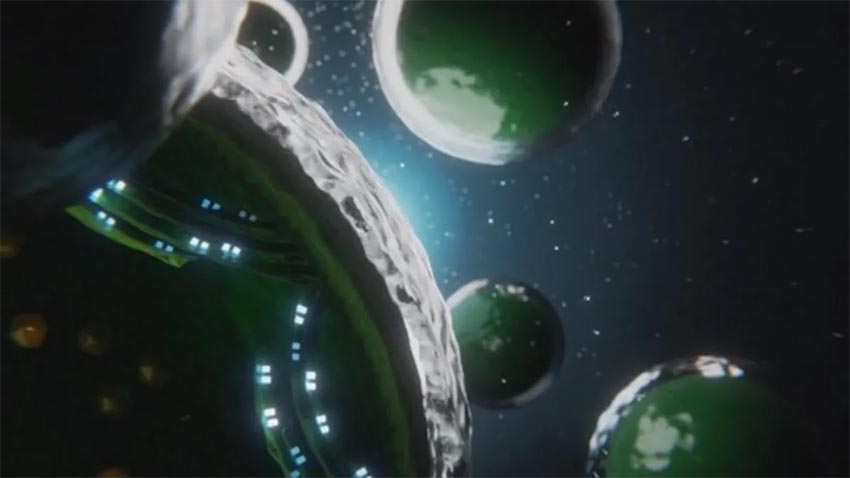|

Scientists Found a 'Leak' in Photosynthesis That Could
Fill Humanity's Energy Bucket
Researchers believe they've discovered a way to tap deeper into one of
nature's most impressive, life-sustaining mechanisms.
March 31, 2023
By Eric
Mack

An illustration of electrons flowing inside plant cells during
photosynthesis.
Tomi Baikie/Cambridge University
Scientists have studied photosynthesis in plants for centuries, but an
international team now believes it has unlocked new secrets in
nature's great machine that could revolutionize sustainable fuels and
fight climate change.
The team says it's determined that it's possible to extract an
electrical charge at the best possible point in photosynthesis. This
means harvesting the maximum amount of electrons from the process for
potential use in power grids and some types of batteries. It could
also improve the development of biofuels. While it's still early days,
the findings, reported
in the journal Nature, could reduce greenhouse gasses in the
atmosphere and provide insights to improve photovoltaic solar panels.
The key breakthrough came when researchers observed the process of
photosynthesis at ultrafast timescales.
"We can take photos at different times which allow us to watch changes
in the sample really, really quickly – a million billion times faster
than your iPhone," Tomi
Baikie, from the University of Cambridge's Cavendish Laboratory,
told CNET.
The team used a technique called ultrafast transient absorption
spectroscopy, which can be most simply understood as lighting up a
sample with laser pulses and recording what happens at extremely short
intervals. This makes it possible to watch electrons as they move
through the entire photosynthetic process.
Previous demonstrations connected cyanobacteria, algae and other
plants to electrodes to create so-called bio-photoelectrochemical
cells that tap into the photosynthetic process to generate
electricity.
Baikie said the researchers were surprised to discover a previously
unknown pathway of energy flow at the beginning of the process that
could enable extracting the charge in a more efficient way.
"We rely on plants for everything we eat and all the air that we
breathe, and maybe we can also use their electrons too."
The scientists found that the place in the cell where photosynthesis
starts was "leaking" electrons. In nature, this could protect plants
from the harmful parts of sunlight.
The discovery of the new, leaky pathway could also have major
implications for the production of renewable biofuels, typically
derived from plants or algae. Biofuels can be carbon neutral because
they both take up carbon dioxide when the plants are grown and release
it back into the atmosphere when burned, versus fossil fuels that
release carbon that's been stored deep in the Earth for eons. How much
carbon biofuel adds or subtracts from the atmosphere depends on how
the plants are grown and how the fuel is produced.
This research could be used to develop more-efficient processes for
creating biofuels.
"It's a completely new approach to biofuel production. We are
gathering electrons from the most early and powerful points of
photosynthesis and rerouting them there," research
coordinator Jenny Zhang, also from Cambridge, said via email.
Zhang says others have attempted to harvest electrons from an earlier
point in the photosynthetic process but concluded it was impossible.
She says that at first, the team was convinced it had made a mistake.

"It took a while for us to convince ourselves that we'd done it," Zhang
said in a statement.
The breakthrough essentially promises to harness more of the
incredible efficiency of photosynthesis when it comes to turning
sunlight into energy.
"What makes photosynthesis really special is its near 100% efficiency
in converting light to electrons," Baikie explained. "By us
understanding the mechanisms of photosynthesis, we can use this
knowledge to inspire us to improve existing solar cell technology."
In addition to producing energy more efficiently, fine-tuning
photosynthesis could also allow for the use of plants to better take
up and store carbon dioxide, helping to fight climate change in the
process.
Zhang imagines a future in which tapping into photosynthesis allows us
to "farm our energy the way we farm our food" but doing so via
organisms like cyanobacteria, which won't require competing with food
production.
In fact, she said, the new insights gleaned from this research could
give crops a boost by making them more tolerant to intense sunlight.
"In the long run, if we can generate renewable energy and fuels from
self-generating, self-recycling, living materials, it would be one of
the greenest options one can imagine going forwards for
sustainability."
Green Play Ammonia™, Yielder® NFuel Energy.
Spokane, Washington. 99212
www.exactrix.com
509 995 1879 cell, Pacific.
exactrix@exactrix.com
|